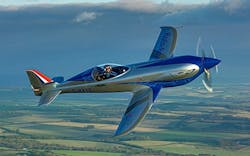Rolls Royce's all-electric Spirit of Innovation claims record topping 387 MPH in Test Flight
Rolls Royce is telling global aviation officials that its new all-electric aircraft is the fastest such plane in the world at almost 390 miles per hour.
The British company’s “Spirit of Innovation” topped out at the purportedly record extended pace of 345.5 over three kilometers just last week, according to the release. Rolls Royce submitted its data to the global Federation Aeronautique Internationale to bolster an verify its claim.
At one point during the test run in United Kingdom skies, the Spirit of Innovation hit 387 miles per hour which, if verified, would achieve the fastest velocity for an all-electric aircraft, according to reports.
“Staking the claim for the all-electric world-speed record is a fantastic achievement for the ACCEL team and Rolls-Royce,” company CEO Warren East said in a statement. “The advanced battery and propulsion technology developed for this program has exciting applications for the Advanced Air Mobility market… this is another milestone that will help make ‘jet zero’ a reality and supports our ambitions to deliver the technology breakthroughs society needs to decarbonize transport across air, land and sea.”
The ‘Spirit of Innovation’ is part of the ACCEL or ‘Accelerating the Electrification of Flight’ project. Half of the project’s funding is provided by the Aerospace Technology Institute (ATI), in partnership with the Department for Business, Energy & Industrial Strategy and Innovate UK.
The aircraft is propelled by a 400kW (500+hp) electric powertrain. Rolls Royce and the ACCEL team worked with aviation energy storage firm Electroflight and automotive powertrain supplier YASA.
The speed run comes only two months of the Spirit of Innovation’s maiden voyage. The electric aircraft also reportedly took less than four minutes to reach nearly 9,000 feet altitude, according to reports.
The Spirit of Innovation’s battery, located in the front half of the airplane body, has 6,480 cells, enough to charge 7,500 phones. The craft’s system voltage is 750 volts, while the motor power is 400 kW.
Portuguese cork is used to insulated the battery heat.
The control and piloting system are near the rear of the plane right in front of the tail section..
------
(Rod Walton, senior editor for EnergyTech, is a 14-year veteran of covering the energy industry both as a newspaper and trade journalist. He can reached at [email protected]).
About the Author
Rod Walton, EnergyTech Managing Editor
Managing Editor
For EnergyTech editorial inquiries, please contact Managing Editor Rod Walton at [email protected].
Rod Walton has spent 17 years covering the energy industry as a newspaper and trade journalist. He formerly was energy writer and business editor at the Tulsa World. Later, he spent six years covering the electricity power sector for Pennwell and Clarion Events. He joined Endeavor and EnergyTech in November 2021.
Walton earned his Bachelors degree in journalism from the University of Oklahoma. His career stops include the Moore American, Bartlesville Examiner-Enterprise, Wagoner Tribune and Tulsa World.
EnergyTech is focused on the mission critical and large-scale energy users and their sustainability and resiliency goals. These include the commercial and industrial sectors, as well as the military, universities, data centers and microgrids. The C&I sectors together account for close to 30 percent of greenhouse gas emissions in the U.S.
He was named Managing Editor for Microgrid Knowledge and EnergyTech starting July 1, 2023
Many large-scale energy users such as Fortune 500 companies, and mission-critical users such as military bases, universities, healthcare facilities, public safety and data centers, shifting their energy priorities to reach net-zero carbon goals within the coming decades. These include plans for renewable energy power purchase agreements, but also on-site resiliency projects such as microgrids, combined heat and power, rooftop solar, energy storage, digitalization and building efficiency upgrades.

